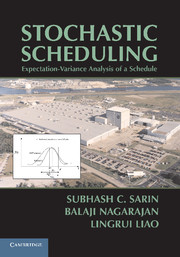Book contents
Foreword
Published online by Cambridge University Press: 05 July 2014
Summary
Over the years, I have taught introductory as well as advanced courses in job scheduling. The problem is fascinating in its variety, which is truly astounding, and in the methodologies that have been offered by many researchers for its resolution. But I have always felt let down when it came to job scheduling under uncertainty: The absence of a comprehensive treatment of these real-life scenarios was a handicap that I felt acutely. After reading this book, I do not feel that way any more.
The fixation on “averages” is often meaningless, if not downright misleading. True, while the statement “on average, such and such phenomenon behaves in a certain way” or “has a particular value” is often a useful bit of information (one is usually interested in the average water temperature at the seaside before taking a jump into the ocean), it often carries insufficient information for intelligent decision making (knowing that one's heartbeat is good “on average” does not help to diagnose the ailment if sometimes it stops beating altogether!). Here is where the “range of variation,” as measured by the variance (or any other measure of dispersion), becomes invaluable.
Scheduling under stochastic conditions has received scant attention from authors in the field. Usually it appears, if at all, in the form of one or two (thin) chapters that introduce the problem and give a treatment based mostly on the assumption that the processing times of the jobs are exponentially distributed. The feeling always has persisted: Whoever heard of processing times that are exponentially distributed? And how to behave if they are not?
- Type
- Chapter
- Information
- Stochastic SchedulingExpectation-Variance Analysis of a Schedule, pp. ix - xPublisher: Cambridge University PressPrint publication year: 2010



